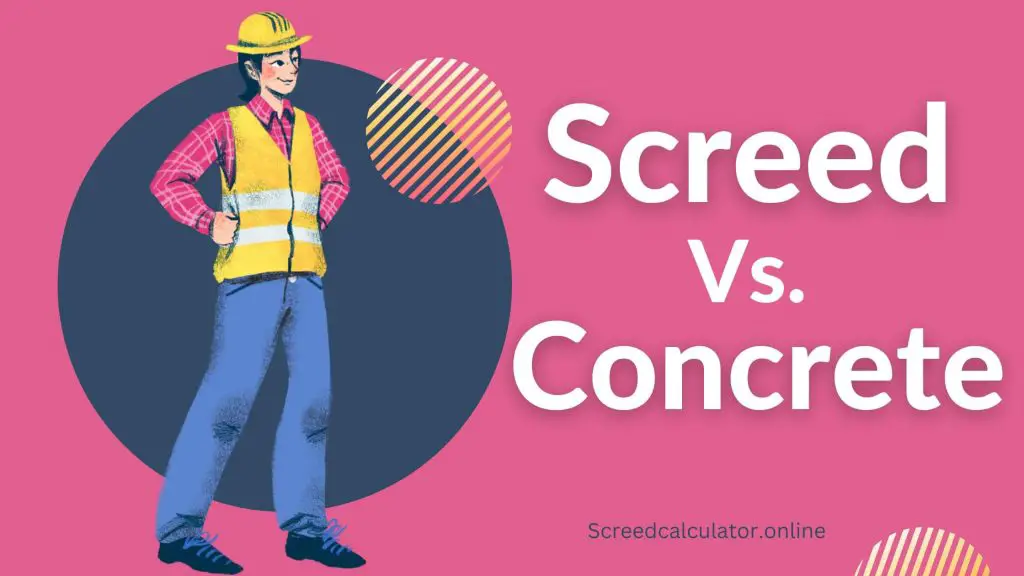
When it comes to construction and flooring, two terms that are often used conversely are “screed” and “concrete.” While they may seem similar, they serve distinct purposes in the construction industry. In this article, we’ll explore the differences between screed and concrete, understanding their specific uses, types, and applications.
Definations:
| Term | Definition |
|---|---|
| Screed | A thin, flat layer of cement or sand used to level surfaces. |
| Concrete | A strong building material made from cement, sand, and water. |
Differences between Screed and Concrete
Different Types of Screed
Here are the three main types of screed used in construction projects:
1. Bonded Screed
Bonded screed, as the name suggests, is applied directly to a concrete substrate. It creates a strong bond with the base, providing enhanced stability and load-bearing capabilities. This type of screed is commonly used when the underlying concrete surface is in good condition and does not require a separate damp-proof membrane.
2. Unbonded Screed
Unbonded screed, on the other hand, is not directly bonded to the concrete substrate. Instead, it is laid over a damp-proof membrane that acts as a barrier between the screed and the base. This prevents any potential issues arising from moisture, ensuring the longevity of the screed.
3. Floating Screed
Floating screed is a unique type of screed that is not in direct contact with the base or the walls. It is installed over an insulation layer, allowing it to move independently, minimizing the risk of cracking due to thermal expansion. Floating screed is commonly used in underfloor heating systems, providing excellent thermal conductivity.
Different Types of Concrete
Here are the 4 main types of concrete:
1. Ready-Mix Concrete
Ready-mix concrete is a pre-mixed solution that is delivered to the construction site. It offers consistency and saves time during the construction process.
2. Precast Concrete
Precast concrete components are manufactured in a controlled environment and then transported to the construction site. This type of concrete offers high-quality, cost-effective solutions.
3. Site-Mixed Concrete
Site-mixed concrete involves mixing the components on-site, providing flexibility in adjusting the mix proportions as per specific project requirements.
4. High-Strength Concrete
High-strength concrete is engineered to have superior compressive strength, making it suitable for high-rise buildings and heavy-load applications.
Screed vs. Concrete
Here is the detailed comparison between Screed and Concrete:
Screed vs. Concrete: A Comparative Analysis
| Aspect | Screed | Concrete |
|---|---|---|
| Composition | Cementitious material with fine aggregates | Cement, sand, gravel, and water |
| Thickness | Thinner layer applied on top of concrete | Heavier and thicker for structural purposes |
| Application | Provides a smooth and level surface | Forms the structural foundation of buildings |
| Bonding | Can be bonded, unbonded, or floating | Directly bonded to the base for stability |
| Purpose | Prepares the surface for final flooring | Main building material for various projects |
| Drying Time | Variable, depending on type and conditions | Typically takes a few days to cure |
| Flexibility | May require reinforcement for strength | Can be reinforced for added durability |
| Usage | Interior flooring and underfloor heating | Foundations, walls, and other structures |
Applications of Screed and Concrete
These are the applications of both screed and concrete in 2023:
Screed vs. Concrete: FAQs
Q: Is screed the same as concrete?
A: No, screed and concrete are not the same. While both are used in construction, they serve different purposes. Concrete is a mixture of cement, sand, gravel, and water, primarily used as a building material, whereas screed is a thinner layer of cementitious material applied on top of the concrete to provide a smooth and level surface.
Q: What is the purpose of screed in construction?
A:The primary purpose of screed is to level the concrete surface and provide a sturdy, even foundation for the final flooring material, such as tiles, wood, or carpet. It also acts as a protective layer, preventing the floor from direct wear and tear.
Q: Can I apply screed myself, or should I hire a professional?
A: While DIY projects can be rewarding, screeding requires expertise and precision to ensure a level surface. To achieve the best results, it is advisable to hire a professional screeder who can deliver a high-quality finish and avoid potential problems.
Q: Can I walk on screed during the drying process?
A: It is essential to avoid walking on screed during the drying process, as it can lead to unevenness and potential damage.
Q: Can I use screed as a final floor finish?
A: No, screed is not a final floor finish but rather a preparatory layer for various floor finishes.
Q: What are the main ingredients in concrete?
A: Concrete is primarily composed of cement, sand, aggregates, and water.
Q: Is concrete more expensive than screed?
A: Generally, concrete can be more expensive than screed, but the cost can vary based on the project requirements.
Q: Can concrete be used for decorative purposes?
A: Yes, concrete can be used decoratively with various finishes and designs.
